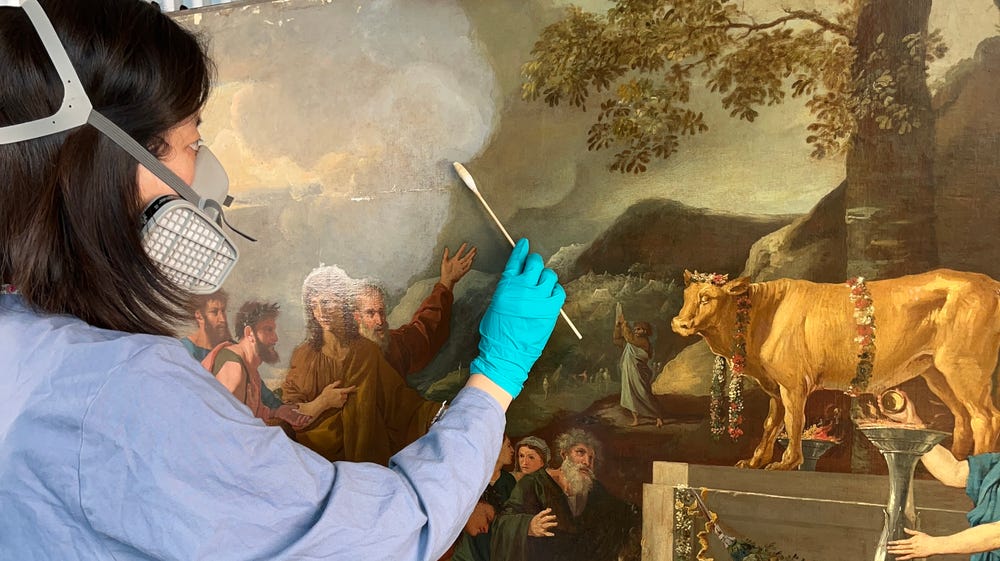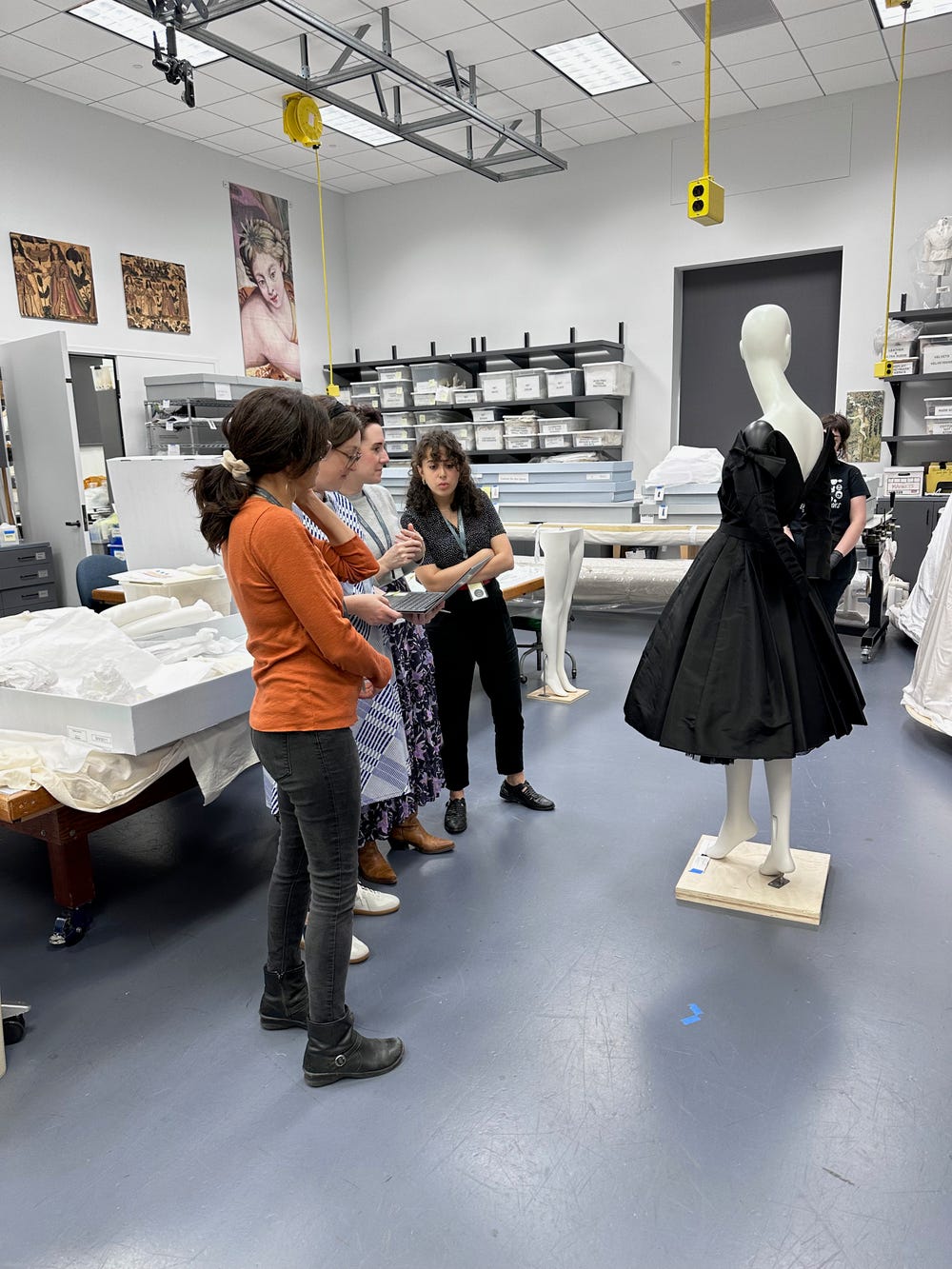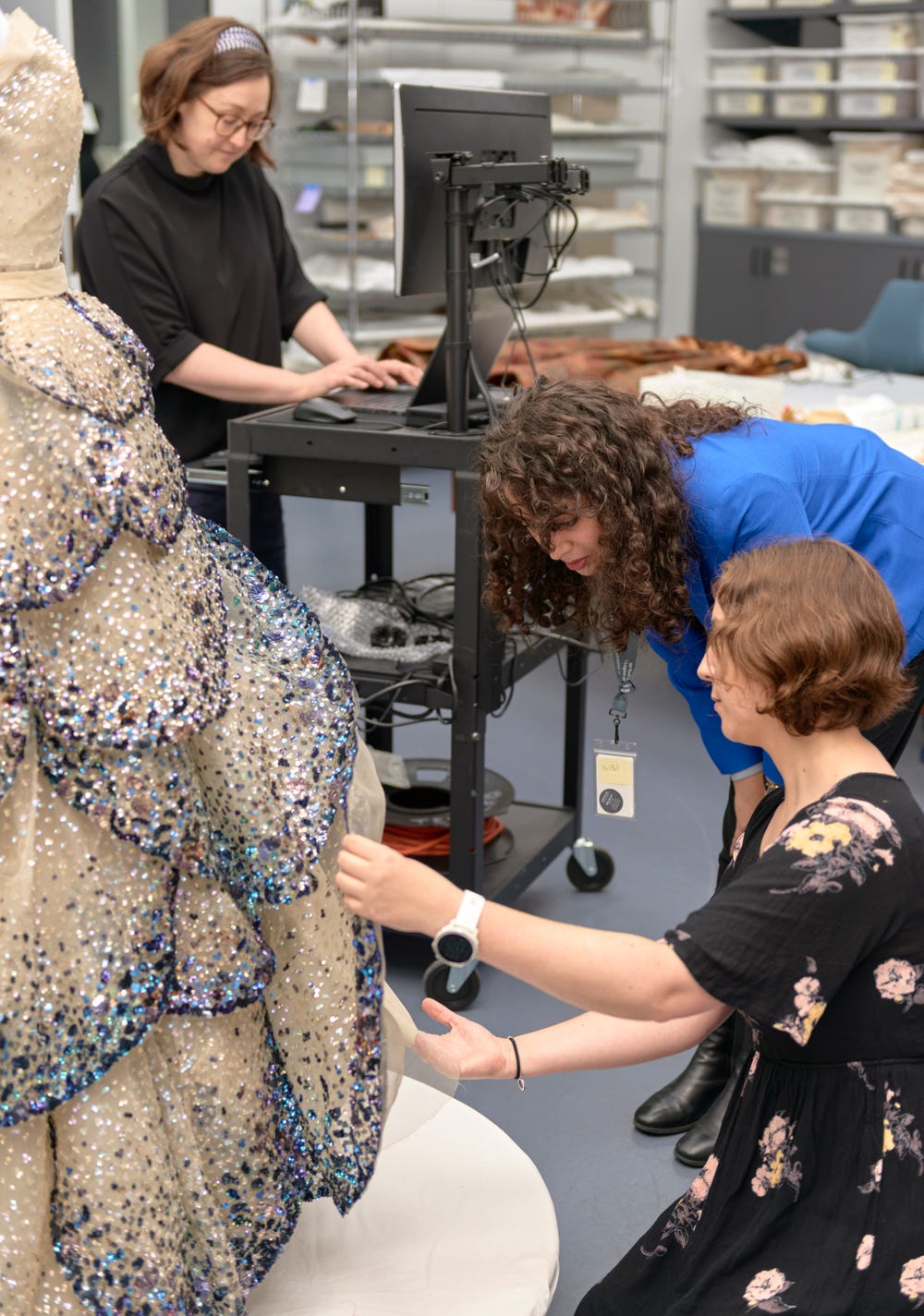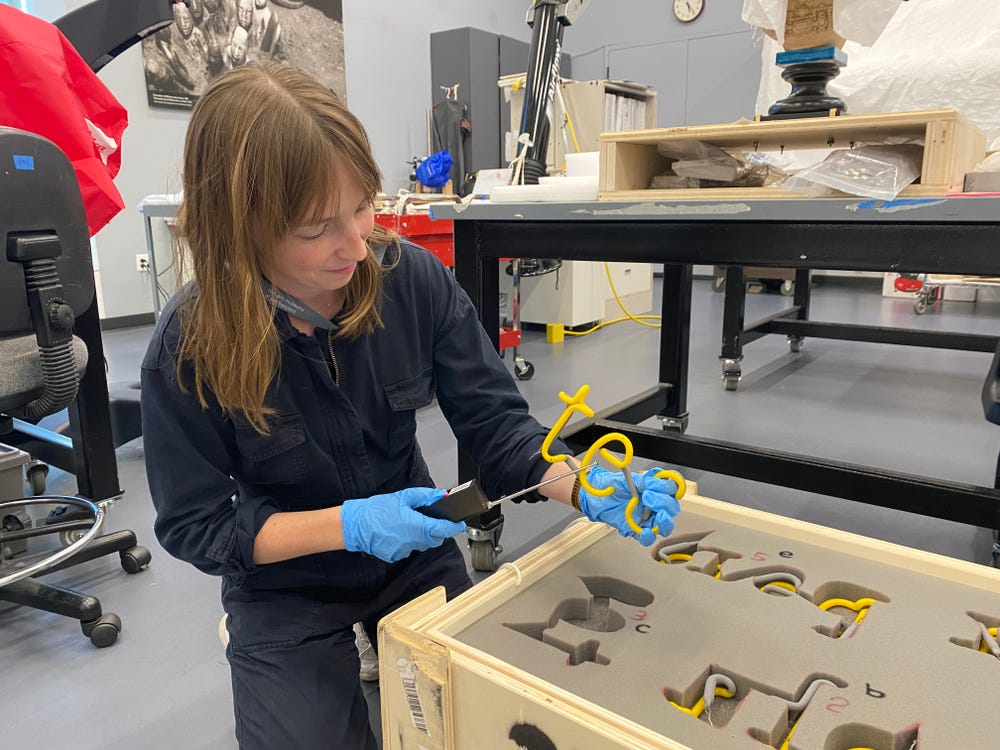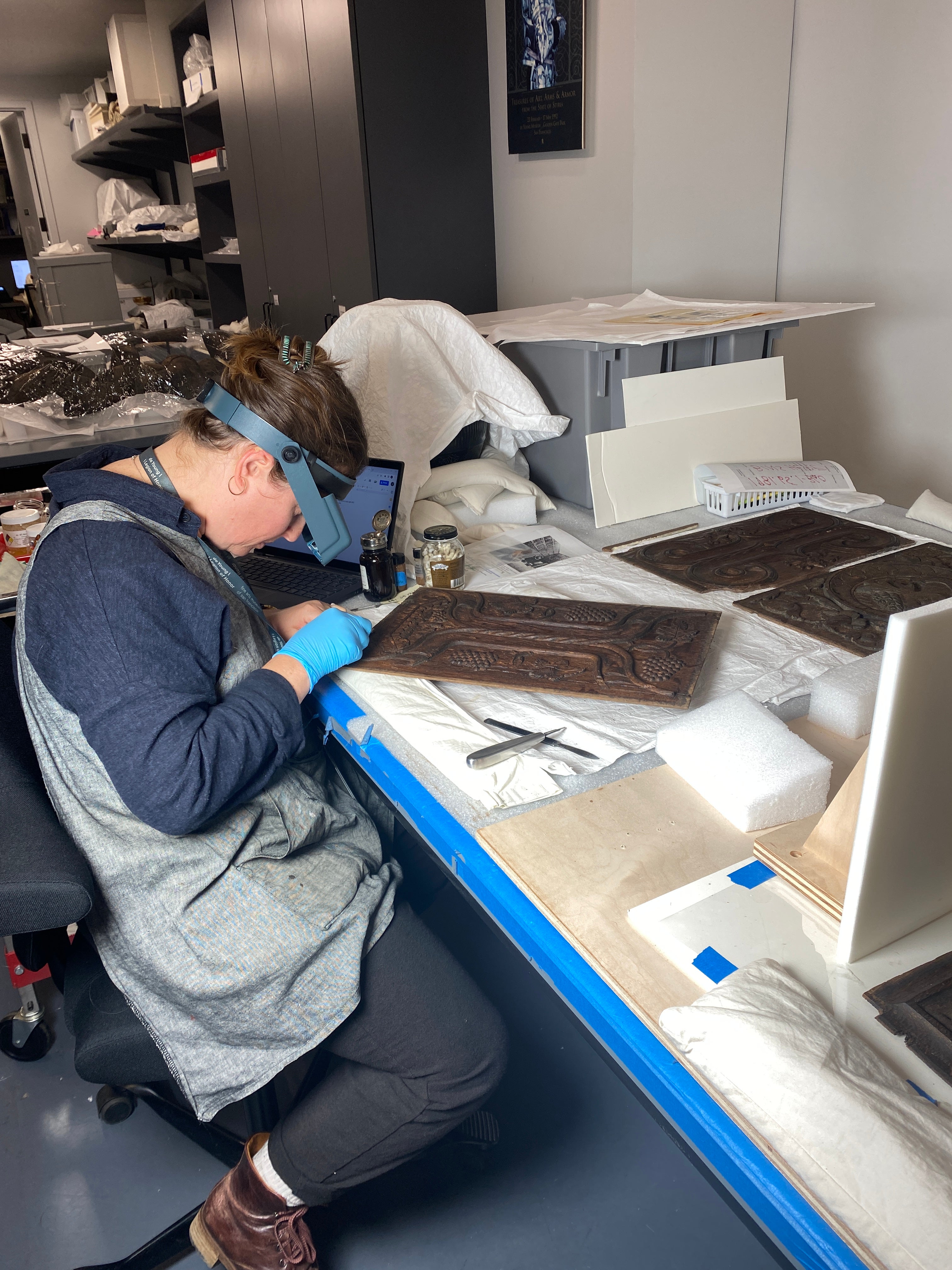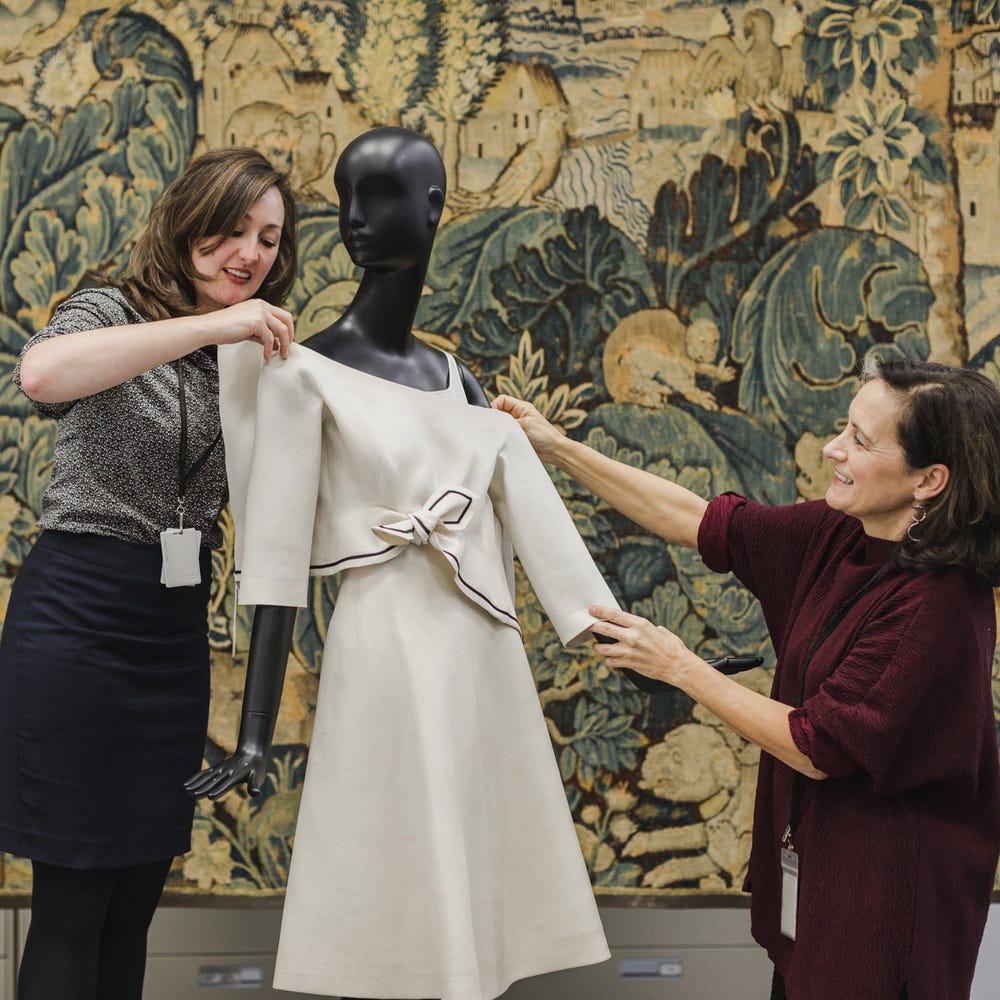Intern Josephine Ren removing the varnish from Adoration of the Golden Calf by Andrea di Leone, 2023
You asked, and our conservators answered. Read on to learn more about what art conservation is, how to become a conservator, and some of the most unusual substances and techniques our conservators have encountered.
What art conservation actually is
What do you do in your daily work?
Elise Effmann Clifford, head of paintings conservation: One of the things I love about being a conservator is the wide variety of our day-to-day work. I could be working in an installation of an exhibition to carefully check a painting that is being loaned to us from another institution, taking an X-ray of a painting in our collection to find out more about how it is constructed, or sitting at my easel retouching paint losses on an artwork that will soon be hung in our galleries. My job is something different every day!
Is there an approval process to working on a piece that needs repair?
Elise, paintings: We work very closely with our curators, who set the treatment priorities. After I’ve studied a painting proposed for treatment by a curator, we get together in the paintings conservation studio to look at and discuss the artwork together. I talk through what I’d recommend for the treatment, answer their questions, and get their approval for moving forward. We then have frequent check-ins throughout the conservation process.
Conservator Anne Getts and mountmaker Camille DuPlantier consult on Christian Dior’s “Indiscrète” (Fall/Winter 1956) with curators Laura Camerlengo and Talia Spielholz. Photo by Beth Szuhay
How often does an oil painting with varnish need to be cleaned?
Elise, paintings: The “need” for a varnish to be removed from a painting is generally a purely aesthetic one, due to yellowing or other aging phenomenon that detract from the overall appearance. The time that elapses before a painting is considered for varnish removal and revarnishing varies by the type and the thickness of the applied layer. To prolong the time between cleanings, conservators typically use thinner layers that are more stable than varnishes used in the past. Whereas it used to be that a noticeable color change could be detected after 25 years, we hope that with our current approach, decades more can go by before a painting needs to be cleaned again.
Do you ever mess up? What stops someone from doing the wrong thing accidentally and ruining the piece?
Elise, paintings: Our training involves understanding the history and chemistry of art materials in our area of specialization, so we have a good grounding on what to expect for an artwork and how to obtain information needed for any future treatment. Close study of the object is vital before any action is performed, and we begin any treatment with small tests and in incremental steps. And, if something cannot be safely treated, then it is always OK to do nothing!
Jane Williams, director of conservation: Although we have many risk management practices in place to prevent them, everyone makes mistakes. We try to learn from situations where things don’t go as expected or planned. A few years ago, our professional organization, the American Institute for Conservation (AIC), started holding a mistakes session at our annual conference. This has been a great way for all of us to get more comfortable with sharing mistakes, and learning from our own and each other’s experiences.
Does there come a point where a conservator recommends no longer displaying an artwork?
Abby Rodriguez, assistant objects conservator: Many condition issues can cause an artwork to no longer be displayable. Some examples are early plastics and rubbers in advanced states of degradation. This can be exacerbated by exposure to light and oxygen in display environments.
Best, worst, and most unusual
What was one of the hardest pieces you have restored?
Jena Hirschbein, associate objects conservator: Each object we treat poses unique challenges. Some examples of particularly difficult treatments are: objects with a super consistent color or sheen that can be easily disrupted, fragile or powdery materials and surfaces, and large and complex pieces like upholstered furniture.
Conservators Anne Getts and Laura Garcia Vedrenne examine Christian Dior’s “Junon” (Fall/Winter 1949) in consultation with curator Talia Spielholz
What’s the most beautiful vintage gown you have restored?
Anne Getts and Beth Szuhay, textile conservators: Probably the most loved and recognizable is a gown designed by Christian Dior for his Fall/Winter collection of 1949, known as “Junon.” It was named in honor of the Roman goddess of marriage and fertility. The curved and heavily sequined petals on Junon’s skirt are meant to evoke the feathers of the peacock — the goddess’s favorite bird. The gown is one of the most documented in our collection, yet we learn something new each time we exhibit her.
In preparation for Fashioning San Francisco: a Century of Style, Junon required boning conservation. Boning is a flat, narrow strip of a strong, flexible material sewn or inserted into seams or casings for structure and support. Junon’s silk and sequined bodice has a net corset with six boning channels. However, her boning was broken or missing. This was problematic on two fronts: one, because of the related damage to the silk bodice and two, because of the loss of original shaping at the bust. We researched to find a replacement that matched the physical characteristics of the original and was chemically stable (would not interact with the surrounding silk or sequins). The boning was replaced prior to mounting, and the original boning was cataloged and stored for future research.
Are there maintenance issues with paintings that use Renaissance glazing?
Isaac Messina, assistant paintings conservator: Thin, translucent glazes used in traditional oil paintings are some of the most sensitive materials. Especially during the Renaissance and Baroque periods, these glazes often incorporated dye-based pigments, like red lake or yellow lake, made from organic materials like madder plants or cochineal insects. While these pigments lend themselves well to painting beautiful glazes, they pose challenges for preservation. Unlike more opaque, metallic or mineral-based pigments, like lead white and vermillion, which are inherently more stable, organic pigments are sensitive to light and can fade over time. They can also be more sensitive to solvents and cleaning systems used for varnish removal.
What is the weirdest substance you have found on/had to clean off an object?
Celine Chretien, associate objects conservator: From fingerprints to unknown goos, we are no strangers to unusual substances. The toothy, matte-black paint on Louise Nevelson’s Ocean Gate (1982) sculpture has long been a magnet for spiders. The sculpture would be covered with the clingiest of webs as soon as we stepped away from trying to clean it. It was repainted last year with a newer paint, developed for stealth jets and approved by the artist’s foundation. It is non-glossy without being so rough and attractive to sticky webs.
Intern Josephine Jenks using a neon tube tester on the neon tube in Joseph Kosuth’s Purloined #1 (W.M.) (2017). Photo by Jane Williams
What is the most unusual or innovative technique you use in your work?
Isaac, paintings: Because conservation is such a small profession, we often borrow tools and materials from other fields — like the culinary world! Xanthan gum, for example, is a common thickening and stabilizing agent in many of our food products, like salad dressings and ice cream. Conservators, too, can use xanthan gum to thicken and emulsify their cleaning solutions. We sometimes mix solvents or water-based solutions with xanthan gum to create a thickened cleaning gel, which is helpful for increasing the contact time with the material while reducing the amount of solvent being applied to the artwork.
Linda Lin, objects conservator: Conservation also adopts technology from medical industries, such as using lasers for cleaning soot and grime on outdoor monuments, or CT scanning to get diagnostic images to understand the structure of an object.
How to become an art conservator
What sort of interests and qualities do conservators have?
Josephine Ren, paintings conservation graduate intern: Conservators tend to be detail-oriented and interested in creative problem-solving.
Linda, objects: Curiosity!
How do you become a conservator?
Josephine R., paintings: Conservators typically receive training at a graduate program in art conservation. Most grad programs require undergraduate coursework in art history, chemistry, and studio art.
We recommend checking out the AIC, as well as these North American art conservation grad programs: Winterthur/University of Delaware, Buffalo State University, the Institute of Fine Arts at New York University, UCLA/Getty Conservation Program, and Queen’s University. There are many programs abroad as well. Reach out to AIC’s Emerging Conservation Professionals Network to learn more.
It is helpful to gain experience through internships in conservation or related fields (collections care, material research, etc.) either at an institution or in private practice. You can connect with local conservators through AIC’s Find a Professional. The University of Delaware also has an online internships and jobs listing that is updated regularly.
Conservator Jena Hirschbein treating Tudor-period oak panels from Paneled Room from Boughton Place, Boughton Malherbe, Kent (ca. 1520–1530). Photo by Jane Williams
Josephine Jenks, paper conservation graduate intern: There are so many different paths to conservation graduate school. In my case, I took studio art and art history courses in college, and then when I realized I wanted to pursue conservation, I took the required chemistry courses at my local college while working part-time.
Other tips/advice for aspiring professional conservators?
Josephine J., paper: Don’t feel like you need to fit a standard mold. Conservators can specialize in painting, sculpture, paper, textiles, books, furniture, and more. Experiences ranging from art handling or framing to woodworking to costuming or tailoring can be assets in this field. Conservators of contemporary, technology-based art often have backgrounds in programming or engineering. Highlight whatever experience you’ve got!
